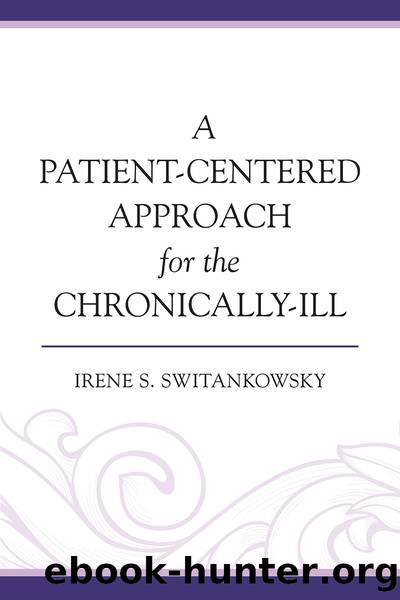A Patient-Centered Approach for the Chronically-Ill by Switankowsky Irene S.;

Author:Switankowsky, Irene S.;
Language: eng
Format: epub
ISBN: 9780761866275
Publisher: UPA
Chapter 7
Successful Decision-Making
The third condition of the patient-centered approach for the chronically-ill is shared decision-making. This type of decision-making is important since patients who suddenly become chronically-ill may not be able to make rational decisions about their future medical treatments on their own. It is, therefore, important that the patient make decisions about treatment options in conjunction with the physician. The physician's role is to guide the patient to make a rational decision about future treatments or medical procedures.
The difficulty with treating chronic illness is that a patient's decision-making capabilities may be biased because of uncertainty of the diagnosis. It is never easy for patients to hear the physician say that they have arthritis, diabetes, or some other chronic condition. We all hope that we'll always be healthy. However, this is an illusion since most of us will ultimately suffer from some type of chronic illness in our lives and we will have to make some important adjustments to our lives in order to cope and live the best life possible regardless.
In this chapter, I will focus on several overarching aspects of successful decision-making which underlie the patient-centered approach to medicine. The foundational components of successful decision-making are empathy and stepping back from a patient's negative attitudes towards the illness and treatment. But before I get ahead of myself, I'll discuss what constitutes a successful decision.
Preliminary Characterization
For the purposes of this discussion, a successful decision is a rational and level-headed choice that is consistent with a patient's values, goals, beliefs and life plans, and which is not influenced by biases and prejudices which are irrelevant to the medical decision at hand. If a chronically-ill patient is on medication, in constant pain or experiencing extreme fatigue, his/her ability to think in a rational manner may be negatively affected. In such cases, the physician should either advise the patient to stop taking the medication before making an important medical decision, or guide the patient to ensure that his/her ultimate decision in favor or against treatment is rational.
According to the patient-centered model, any paternalistic form of influence on decision-making can violate a patient's cognitive capacity for making his/her own decisions about medical treatments. Physicians must, therefore, ensure that they are guiding the patient but not prescribing what they consider are the most beneficial treatments on the patient's behalf. To guide means to think along with the patient, and encourage him/her to deliberate rationally. This process is typically most effective when physicians keep asking the patient some specific questions about the treatments to ensure that (s)he has, in fact, fully understood them during the disclosure.
The Three Dimensions of Rational Decision-Making
Chronically-ill patients usually experience some sort of continuous pain and fatigue for a prolonged period of time. Such patients may often been prescribed psychologically debilitating medications. The physician must devise special methodologies and procedures for making medical decisions with such a patient. It is obvious that physicians cannot ensure that a rational decision is made by each chronically-ill patient; however, if a patient has adequate
Download
This site does not store any files on its server. We only index and link to content provided by other sites. Please contact the content providers to delete copyright contents if any and email us, we'll remove relevant links or contents immediately.
Application of a Novel Technique for Clinical Evaluation of Nitric Oxide-Induced Free Radical Reactions in ICU Patients by Unknown(696)
Rosenâs Emergency Medicine Concepts and Clinical Practice by Ron Walls; Robert Hockberger; Marianne Gausche-Hill; Timothy B. Erickson; Susan R. Wilcox(572)
Oxidative damage to surfactant protein D in pulmonary diseases by Vitality Starosta1 & Matthias Griese1†(408)
Social Science Perspectives on Global Public Health by Vincent La Placa & Julia Morgan(373)
Constructing Canine Consent; Conceptualising and Adopting a Consent-focused Relationship with Dogs by ERIN JONES(330)
Organic Chemistry: An Acid - Base Approach by MICHAEL SMITH(299)
ADVANCED EMERGENCY CARE AND TRANSPORTATION OF THE SICK AND INJURED by Unknown(271)
Saunders Nursing Drug Handbook 2024 - E-Book by Unknown(263)
Socio-Life Science and the COVID-19 Outbreak : Public Health and Public Policy by Makoto Yano; Fumihiko Matsuda; Anavaj Sakuntabhai; Shigeru Hirota(247)
Diagnostic and Statistical Manual of Mental Disorders, Fifth Edition, Text Revision (DSM-5-TR(tm)) by Unknown(246)
Davis's Comprehensive Manual of Laboratory and Diagnostic Tests with Nursing Implications by Unknown(245)
Human Microanatomy; Cell Tissue and Organ Histology with Celebrity Medical Histories by Stephen A. Stricker(243)
Berne and Levy Physiology E-Book by Unknown(234)
Handbook of Skin Disease Management by Jiyad Zainab;Flohr Carsten; & Carsten Flohr(229)
Replacing the Dead by Mie Nakachi;(229)
Access to Medicines and Vaccines in the South : Coherence of Rules and Policies Applied by the European Union Commission by Stephen Kingah(225)
The Pocket Guide to Sensorimotor Psychotherapy in Context (Norton Series on Interpersonal Neurobiology) by Pat Ogden(218)
Deep Learning and Medical Applications by Unknown(218)
Advances and Technical Standards in Neurosurgery by Unknown(215)
